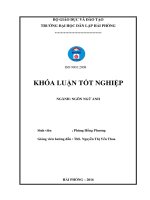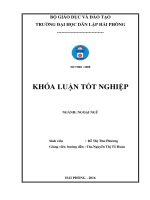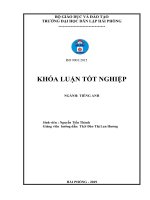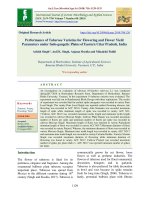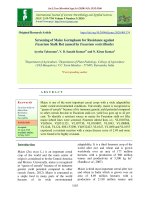Screening of potato germplasm for flowering and self incompatibility (khóa luận tốt nghiệp)
Bạn đang xem bản rút gọn của tài liệu. Xem và tải ngay bản đầy đủ của tài liệu tại đây (1.41 MB, 60 trang )
VIETNAM NATIONAL UNIVERSITY OF AGRICULTURE
FACULTY OF BIOTECHNOLOGY
--------� � � --------
UNDERGRADUATE THESIS
TITLE:
SCREENING OF POTATO GERMPLASM FOR
FLOWERING AND SELF-INCOMPATIBILITY
Hanoi-2022
VIETNAM NATIONAL UNIVERSITY OF AGRICULTURE
FACULTY OF BIOTECHNOLOGY
--------� � � --------
UNDERGRADUATE THESIS
TITLE:
SCREENING OF POTATO GERMPLASM FOR
FLOWERING AND SELF-INCOMPATIBILITY
Practicing student’s name : TRAN THI TRANG
Student's code
: 620643
Class
: K62CNSHE
Faculty
: BIOTECHNOLOGY
Supervisor
: PHANHUU TON, PROF. PH.D.
Hanoi - 2022
COMMITMENT
I hereby declare that the data and research results in this thesis are true and
do not copy the results of any previous undergraduate reports.
Undergraduation thesis with references to documents, citation information
is indicated in the references section.
Hanoi, March 9th, 2022
Sincerely,
Tran Thi Trang
i
ACKNOWLEDGEMENT
In order to complete the undergraduation thesis, in addition to my own
efforts, I have received the great attention and support of teachers, friends as
well as family members.
First of all, I would like to express my deep gratitude to PhanHuu Ton,
Prof. Ph.D., who enthusiastically guided, oriented, and helped me professionally
throughout the process of completing my graduation thesis.
Secondly, I would like to thank Engineers PhanThanh Tung, PhanHuu Hien
and PhamDinh On work at the Center for Conservation and Development of
Crop genetic resources and all teachers in the Department of Molecular Biology
and Applied Biotechnology, Faculty of Biotechnology, Vietnam National
University of Agriculture, are very enthusiastic to help, create the most
favorable conditions for me during my internship at the center and the subject. I
would also like to thank the teachers of the Vietnam National University of
Agriculture for equipping me with the necessary knowledge over the past 4
years so that I could conduct and complete my undergraduation thesis.
Finally, I would like to sincerely thank my family members, brothers and
sisters, friends who have encouraged, helped and created conditions for me to
complete this undergraduation thesis.
ii
CONTENTS
COMMITMENT ...........................................................................................................i
ACKNOWLEDGEMENT .......................................................................................... ii
CONTENTS ................................................................................................................ iii
LIST OF TABLES ........................................................................................................ v
LIST OF FIGURES AND GRAPHS .........................................................................vi
LIST OF ABBREVIATIONS ................................................................................... vii
Chapter 1. INTRODUCTION ..................................................................................... 1
1.1. Introduction ............................................................................................................. 1
1.2. Purpose .................................................................................................................... 2
1.3. Requirement............................................................................................................. 2
Chapter 2. OVERVIEW OF POTATO ...................................................................... 3
2.1. General introduction ................................................................................................ 3
2.1.1. Origin and classification of potato crop ............................................................... 3
2.1.2. Botanical properties of the potato crop ................................................................ 4
2.1.3. Biological characteristics of potato crop .............................................................. 6
2.1.4. Genetics and reproductive characteristics of potatoes ......................................... 7
2.1.5. Some factors affect the growth and development of potato crop ....................... 13
2.1.6. Nutritional requirements of potato crop ............................................................. 14
2.1.7. Nutritional value ................................................................................................. 15
2.1.8. Storing potatoes .................................................................................................. 16
2.1.9. Toxicity............................................................................................................... 16
2.1.10. Role in the World Food Supply ........................................................................ 18
2.1.11. Time to plant potatoes in Vietnam ................................................................... 18
2.2. The situation of potato production in the world .................................................... 19
2.3. Potato production situation in Vietnam ................................................................. 21
2.4. Self-incompatibility gene ...................................................................................... 22
Chapter 3. MATERIAL AND METHOD ................................................................ 24
3.1. Material .................................................................................................................. 24
3.2. Location and time .................................................................................................. 24
3.3. Research contents .................................................................................................. 25
iii
3.4. Methods ................................................................................................................. 25
3.4.1. Experimental design ........................................................................................... 25
3.4.2. Evaluation method of some agro-biological characteristics............................... 26
3.4.3. PCR method to identify self-incompatibility genes (S11 and S16) (Olga Marcellan
et al, 2012). ................................................................................................................... 27
3.4.5. Evaluation of flowering. ..................................................................................... 29
Chapter 4. RESULTS AND DISCUSSION ............................................................. 30
4.1. Evaluation results of some agro-biological characteristics ................................... 30
4.1.1. Results of monitoring some indicators of growth and development
characteristics ............................................................................................................... 30
4.1.2. Results of monitoring a number of indicators on yield and quality of tubers
...................................................................................................................................... 35
4.2. Results of PCR method to identify self-incompatibility genes (S11 and S16) ............... 41
4.2.1. DNA extraction results ....................................................................................... 41
4.2.2. PCR results ......................................................................................................... 42
4.3. Results of evaluating the flowering ability of the experimental varieties ............. 45
Chapter 5. CONCLUSION AND SUGGESTION................................................... 47
5.1. Conclusion ............................................................................................................. 47
5.2. Suggestion ............................................................................................................. 48
REFERENCES ........................................................................................................... 49
iv
LIST OF TABLES
Table 2.1. Scientific classification ........................................................................ 4
Table 2.2. Representative potato genetic markers and maps. ............................. 10
Table 3.1. List of screening materials. ................................................................ 24
Table 3.2. DNA molecular markers used in the experiment............................... 28
Table 4.1. Growth time tracking table. ............................................................... 30
Table 4.2. Monitor stem and leaf characteristics. ............................................... 33
Table 4.3. Yield survey data of potato varieties. ................................................ 36
Table 4.4. Quality monitoring table of tubers. .................................................... 39
Table 4.5. PCR results to detect S11 and S16 self-incompatibility genes............. 43
v
LIST OF FIGURES AND GRAPHS
Figure 2.1. Parts of the potato plant. ..................................................................... 5
Figure 4.1. Results of total DNA electrophoresis of 40 potato varieties. ........... 41
Figure 4.2. Electrophoresis results of PCR products detecting selfincompatibility genes S11 and S16. ............................................................... 42
Figure 4.3. Flower images represent a number of varieties with flowering. ...... 45
Figure 4.4. Image of tubers of high yielding potato varieties. ............................ 46
vi
LIST OF ABBREVIATIONS
AFLP: amplified fragment length polymorphism
CTAB: cetyltrimethylammonium bromide
DArT: diversity array technology
DNA: deoxyribonucleic acid
EDTA: etylenediaminetetraacetic acid
GSI: gametophytic self-incompatibility
ISSR: inter simple sequence repeat
PCR: polymerase chain reaction
RAPD: random amplified polymorphism
RFLP: restriction fragment length polymorphism
RGL: resistance gene-like fragment
SI: Self-incompatibility
SLF: S-locus F-box
SNP: single nucleotide polymorphism
S-RNase: S-Ribonucleases
SSCP: single stranded conformation polymorphism
SSR: simple sequence repeat, microsatellite
TE: Tris-EDTA
vii
Chapter 1. INTRODUCTION
1.1. Introduction
Potato, Solanum tuberosum, belongs to the family Solanaceae, native to the
Andes mountains of Bolivia and Peru, is a short-term crop, occupying an
important role in food crops for people. Currently, potatoes are the world's most
widely grown as root crop and the fourth most popular crop in terms of yield behind rice, wheat and maize.Potatoes have the characteristics of being easy to
grow, giving a short harvest and adapting to different environmental conditions.
Potato production has many forms such as: asexual propagation, sexual
propagation, tissue culture. In which, sexual propagation is a method of
propagation by seeds, but this method is rarely used because in potatoes there is
a phenomenon of self-incompatibility which hinders inbreeding.
Self-incompatibility (SI) is common in tuber-bearing Solanum species,
especially at the diploid level. In most diploid potato genotypes, inbreeding is
severely limited by a gametophytic self-incompatibility (GSI) system that is
controlled by the multi-allelic S-locus (16 alleles name as S1, S2, ...S16), each
allele codes for one S-RNase (S-Ribonucleases) and several S-locus F-box
(SLF) with different pollen-specific traits, the S locus location was identified on
chromosome I. Molecularly, self-incompatibility is due to the cytotoxic effect of
S-RNases that inhibit pollen tube growth preventing fertilization.
In order to serve potato breeding by seed, it is necessary to investigate the
potatoes germplasm for some agro-biological characteristics and selfincompatibility alleles using PCR-based DNA molecular markers. Currently, the
Center for Conservation and Development of Crop Genetic Resources has
collected a potatoes germplasm, which is a diverse genetic resource for the study
of self-incompatibility genes for potato breeding by seed. So with the guidance
of PhanHuu Ton Prof. Ph.D., we conduct the title: "Screening of potatoes
germplasm for flowering and self-incompatibility".
1
1.2. Purpose
Evaluation of some agro-biological characteristics, determining the ability
flowering and containing genes of self-incompatibility (S11 and S16) of the
studied potato varieties.
1.3. Requirement
Evaluation of some agro-biological characteristics affecting the growthdevelopment, yield and quality of the studied potato varieties.
Determining the ability to contain self-incompatibility genes (S11 and S16)
of the studied potato varieties.
Evaluation of flowering ability of studied potato varieties.
2
Chapter 2. OVERVIEW OF POTATO
2.1. General introduction
Potatoes (Solanum tuberosum), belonging to the Solanaceae family, are
grown for their starchy tubers. They are the world's most widely grown root crop
and the fourth most popular crop in terms of fresh yield - behind rice, wheat and
maize. Potato is one of the crops with high economic efficiency because of its
short growing time (80-100 days), easy to grow, high yield in mild climate
conditions with suitable temperature from 18 – 23oC (up to 5-20 tons of
tubers/ha) and contains high nutrient content. Potatoes were introduced to the
United States in 1719, to India in 1615, to China in 1700, to Japan in 1766 and
to Vietnam in 1890. In our country, potatoes are mainly grown in the Northern
provinces in Autumn season, in which the area with favorable conditions could
expanded.
2.1.1. Origin and classification of potato crop
Origins
Potato (Solanum tuberosum) is native to South America. In the early 16th
century, the Spanish navigators who conquered South America brought them to
grow in their country. At the end of the sixteenth century, potatoes were grown
in Ireland, England, Germany, France and then potatoes were grown in many
other European countries. Asian countries and other continents became aware of
potatoes later than European countries through the colonial policy of Europeans.
In our country, potatoes were brought to some places by the French in 1890
and mainly grown in the Red River Delta. The popular potato variety previously
grown is Thuong Tin yellow-fleshed potato variety, which is derived from the
Ackersegen variety, imported from France in 1890.
Scientific classification
3
Table 2.1. Scientific classification
Kingdom
Plantae
Order
Solanales
Family
Solanaceae
Subfamily
Solanoideae
Tribus
Solaneae
Genus
Solanum
Species
S.tuberosum
2.1.2. Botanical properties of the potato crop
Potato plants are herbaceous perennials that grow about 60 cm high,
depending on variety, with the leaves dying back after flowering, fruiting and
tuber formation. Tuber stolons develop from shoots, with favorable conditions
will develop into tubers, unfavorable conditions will shoot pop up to the ground
to develop into branches. Potato flowers are white, pink, red, blue, or purple
flowers with yellow stamens. Potatoes are mostly cross-pollinated by insects
such as bumblebees, which carry pollen from other potato plants, though a
substantial amount of self-fertilizing occurs as well. Tubers form in response to
decreasing day length, although this tendency has been minimized in
commercial varieties.
4
Figure 2.1. Parts of the potato plant.
After flowering, potato plants produce small green fruits that resemble
green cherry tomatoes, each containing about 300 seeds. Like all parts of the
plant except the tubers, the fruit contain the toxic alkaloid solanine and are
therefore unsuitable for consumption. All new potato varieties are grown from
seeds, also called "true potato seed" or "botanical seed" to distinguish it from
seed tubers. New varieties grown from seed can be propagated vegetatively by
planting tubers, pieces of tubers cut to include at least one or two eyes, or
cuttings, a practice used in greenhouses for the production of healthy seed
tubers. Plants propagated from tubers are clones of the parent, whereas those
propagated from seed produce a range of different varieties.
5
2.1.3. Biological characteristics of potato crop
The growth and development stages of potato plants can be divided into 4
periods:
Rest period:
The dormant period of the potato means that the potato has just been
harvested and is not capable of sprouting.
The factors affecting the dormancy period of potato plants depend on the
variety, mechanical application and chemicals as well.
After being broken dormancy, the potato tuber has the ability to sprout.
Germination period:
The sprouting period is the first development stage.
At the nodes of the potato tubers grow small sprouts and these sprouts will
develop into seedlings.
The following factors determine the germination rate of potato plants:
Seed tubers: choose tubers that are not scratched, rotten, sprout fast, and
healthy sprouts.
Temperature: 22-30oC, if the temperature is lower, it will make it difficult
for the plants to sprout
Soil moisture: about 80-85%, if the soil is too dry, it will also slow down
the growth of the plant, if the soil is too wet, it will cause the tubers to rot.
Old tubers will sprout faster than young bulbs.
If the temperature is warm, the tubers will sprout very quickly.
In one nodes tuber, the middle sprout will sprout first.
The sprouts at the top of the tubers grow faster and stronger than the
sprouts at the base of the tubers.
On a tuber, the sprouts that grow first usually grow faster and inhibit the
sprouts at the base. When one sprout is broken, other sprouts will have a chance
to growth.
6
The period of tuber ray formation:
After growing about 15-20 days, potato plants will form tuber rays very
soon.
Depending on the variety, care regime as well as the growing season, the
period of tuber ray development can be short or long, usually lasting about 3045 days.
Suitable temperature: 17-20oC.
Suitable humidity: 70-80%.
The soil must be loose, airy and clean.
The period of tuber development:
This is the stage when nutrients are transported to the tuber to help the tuber
grow quickly and make the tuber swell.
This period lasts about 25-30 days depending on the variety.
Tubers grow very quickly if the day and night temperature difference is high.
Low temperature, short day light, moist soil and adequate supply of
nutrients will help tubers grow very quickly.
The factors that determine the yield of potato plants: appropriate planting
time, care such as watering, fertilizing.
2.1.4. Genetics and reproductive characteristics of potatoes
The diversity of potato species has been discussed in a special issue by
Machida-Hirano (2015) regarding the geographical distribution and variation of
species. Commonly cultivated potato cultivars include tetraploid (2n = 4x = 48)
with a haploid chromosome number of 12, while there are species grown in
diploid (2n = 2x = 24) to pentloid (2n = 5x = 60). Triploid and pentaphyletic
species are grown only on the highlands and slopes of the Andes, but diploid
cultured species are more widely grown and are also used to breed tetraploid
cultivars. Wild and cultivated potato genetic resources provide a variety of
genetic and reproductive traits related to species differentiation and breeding
applications.
7
Reproductive characteristics:
Breeding
Potatoes can be propagated vegetatively by tubers, tissue culture, or even
by cuttings. Usually ―seed‖ means the tubers in the potato community, and
potato seed actually means the plant seed. Potato species can also produce true
potato seeds. The potato fruit looks like a small green tomato. One fertile fruit
can contain more than 200 true potato seeds in tetraploid varieties. While diploid
wild species are often self-incompatible, tetraploid cultivars and polyploid
species are self-compatible. Furthermore, many polyploid species are anomalous
polyploids with autophagy in nature, but they have the potential to produce
autotrophic seeds and tubers.
Gametes 2n
The 2n gametes are somatic chromosome numbers, often confused with
non-meiosis gametes. Non-meiosis gametes are gametes that do not undergo
genetic recombination during gametogenesis, that is, no meiosis and no
reduction in the number of chromosomes. 2n gametes contribute to
polyploidization and enable the transition from haploid to polyploidy. The 2n
gametophyte has been used to produce diploids in propagation in many taxa of
higher plants, contributing to polyploidization and having heritability from
haploid to polyploid.
Haploid
Haploids from tetrapods, which are diploids, occur naturally and can also
be introduced by aneuploidy using special pollinators. The efficiency of haploid
production varies by pollinator species. Haploid species from tetrapods usually
do not flower and are also male sterility due to inbreeding during haploidization.
Selection of haploids can lead to diploid lines to obtain wild diploid genetic
variants and F1 crosses between haploids, and wild species can be used as
bridges Genotyping to transfer useful traits from diploid to tetraploid. In
addition, this haplotype is used to study the segregation of traits at the tetraploid
8
level if multiple haploid genotypes are generated from a single tetraploid
genotype.
Self-incompatibility
Self-incompatibility is common in tuberous Solanum species, especially at
the diploid level. Locus S controls self-incompatibility (SI) consisting of two
tightly bound alleles: S-RNase (S-locus-RNase) and multiple SLFs (S-locus Fbox protein). Inwhich locus S with multiple alleles control gamete selfincompatibility. The genetic structure of the S gene is quite simple: the S 2 allele
consists of two exons and one intron, with a rate of 117bps for a total size of 786
bps (Kaufmann et al., 1991). The S site has been identified on chromosome I. A
rare self-compatibility mutant gene, Sli, has also been identified, and this unique
mutant gene may allow the establishment of pure genetic lines for study
breeding value of heterozygosity in potato (Hosaka and Hanneman 1998). The
Sli gene is mapped at the distal end of chromosome XII; therefore, the Sli gene
is independent of the S locus.
Male sterility
Male sterility usually occurs in tetraploid cultivars and related taxa. It is a
consequence of nuclear-cytoplasmic interaction; the dominant Msgene interacts
with the cytoplasm of the genus S. tuberosum of the Tuberosum group to induce
male sterility and the Rt dominant gene restores fertility. The emergence of male
sterility is often difficult for potato breeders, as selection of parental lines can
limit the penetration of traits. However, once the genotypic information related
to male sterility is sorted, prediction can easily be made to select parental lines
to enhance the genetic pool.
Genomes
The first potato genome was reported in 1988 using the restriction fragment
length poylmorphism (RFLP) markers (Bonierbale et al. 1988).
9
Table 2.2. Representative potato genetic markers and maps.
Number of loci or
markers
cM
References
Comments
RFLP
(restriction
fragment
length
polymorphism)
135
1189
Bonierbale et
al. (1988)
First potato map
RFLP
141
690
Gebhardt et
al. (1989)
High heterozygosity
observed in diploid
Marker type
genetics lines
RFLP
304
1034
Gebhardt et
Increase of mapped
al. (1991)
loci
RFLP
1030 (average 1.2
cM interval)
1276
Tanksley et
al. (1992)
Highly saturated map
for comparison with
tomato
RFLP,
transposons,
isozymes
175
1120
Jacobs et
al. (1995)
Integration of known
loci and new markers
AFLP
(amplified
fragment
length
polymorphism)
770
–
Vos et
al. (1995)
van Eck et
al. (1995)
Rouppe van
der Voort et
al. (1998)
AFLP used on
potatoes and high
resolution is possible
RGL
(resistance
gene-like
fragment)
Concept generation
for landmark
–
Leister et
al. (1996)
Applicability for
disease and pest
resistances
SSR
89
–
Milbourne et
al. (1998)
Fingerprinting
ISSR (inter
simple
sequence
4
–
Prevost and
Wilkinson
(1996)
Validation for
fingerprinting
10
Marker type
Number of loci or
markers
cM
References
Comments
repeat)
RAPD (random
amplified
polymorphism)
, RFLP
100
606
Hosaka and
Hanneman
(1998)
An example of targettrait-specific rapid
generation of mapping
COS
(Conserved
Ortholog Set)
1025
–
Fulton et
al. (2002)
Further validation of
tomato-potato
orthology
SSR
156
–
Ghislain et
al. (2004)
15 SSR marker sets
selected as highly
informative
SSR (simple
sequence
repeat,
microsatellite)
61
–
Feingold et
al. (2005)
EST-based SSR
Multiple gene
family
homologues
15 primer pairs
produced 27 loci
–
Yamanaka et
al. (2003, 20
05)
Simple approach to
make a marker and
map
AFLP
10,305 (10,365
with markers such
on CAPS, SCAR)
751
maternal
/773
paternal
Van Os et
al. (2006)
Small number of
progeny individuals
with 130 and 381
AFLP primer
combinations made
over 10,000 markers
NB-LRR
disease
resistance gene
homologues
738 RGLs
47 R gen
es
physicall
y
mapped
Bakker et
al. (2011)
BAC-based physical
map of R genes
NB-
438
370 R ge
Jupe et
nes
physicall
al. (2012)
(P450)
LRR R genes
11
Marker type
Number of loci or
markers
cM
References
Comments
y
mapped
BAC physical
map
2800 contigs
1.64
times the
coverage
of the
genome
de Boer et
al. (2011)
Foundation for
genome sequencing
SNP (single
nucleotide
polymorphism)
, SSR, AFLP,
DArT
(diversity array
technology)
2469
936
Sharma et
al. (2013)
Integration of genetic
and physical maps
12
2.1.5. Some factors affect the growth and development of potato crop
Temperature
Temperature is a particularly important meteorological factor that directly
affects the growth and development of potato plants. During the vegetative
growth period, potato plants can adapt to a temperature range of 10-25oC, which
is wider than that of the vegetative growth stage. According to Billd-Deau
(1992), the suitable temperature for potato tuber formation is 18 - 20oC, from
20oC and above the potato tuber formation process will be inhibited, the dry
matter volume of the tubers as well as the quality tubers are reduced, if the
temperature is too low, it also affects the growth of the tubers. When the
temperature drops below 15oC, the characteristics such as shell membrane,
starch content change in an unfavorable direction.
Light
Potato is a light-loving plant, suitable light intensity will give high yield.
Strong light intensity is favorable for photosynthesis, which is favorable for the
formation and accumulation of dry matter. Photosynthetic intensity is weak,
many tubers will not be able to form tubers.
Different growing periods of potato plants have different lighting
requirements. From the time the potato begins to grow out of the ground to the
time when the flower buds appear, long daylight is required. The tuber
development period requires short daylight.
Humidity
During the growth stages, potato plants have different water requirements.
The period from planting to the appearance of tubers needs to ensure a minimum
soil moisture of 60-80% of the field moisture capacity. During the growing
period of tubers, it is necessary to regularly keep the soil moisture at 80%. Lack
or excess of water both adversely affect plant growth.
13
Soil and soil pH
The most suitable soil for growing potatoes is light alluvial soil, mixed
sandy soil, light loose soil with high humus content, thick arable soil layer, good
moisture retention, good irrigation. Potatoes can grow on soil with a pH of 4.87.1; The ideal pH for potato plants is 5.2-6.4. If the pH is above 7 potato plants
are susceptible to tuber scab.
2.1.6. Nutritional requirements of potato crop
Potatoes require a large amount of nutrition and are full of macro and trace
elements. The effect of nitrogen on potato yield has been studied since the
1970s. Applying too much nitrogen to potatoes will reduce the yield and quality
of potato tubers. Potatoes fed from 45-400kg N/ha will give optimum yield.
Potatoes also need a lot of phosphorus (P) for growth, however, the
effectiveness of P is highly dependent on the content of P and lime in the soil.
The amount of P present in the soil is low and the amount of free lime is high, it
is usually necessary to apply a higher dose of P. Many research results show that
the effect of potassium is not clear on potato yield, but it is clearly related to
tuber quality, namely tuber dry matter content, reducing black spot disease on
tubers. Potassium increases photosynthesis, increases the transport of substances
in plants and increases resistance to pests and diseases.
Trace elements such as Magnesium (Mg), Zinc (Zn), Sulfur (S) ... need to
provide adequate and balanced for plants. If there is a lack of plants, the growth
will be poor, and the yield will be low.
Organic fertilizers play a very important role in potato production. If you
want to have high yield and yield of good quality potatoes, you must use organic
fertilizers because organic fertilizers provide a balance of macro- and semimacro elements (N, P, K, Ca) for potatoes and especially fully supplement the
important trace elements needed for potatoes. In addition, organic fertilizers also
14
create porosity in the soil, increase soil moisture retention, stimulate root
development and create favorable conditions for the formation and development
of potato tubers.
2.1.7. Nutritional value
Potatoes contain vitamins, minerals and a variety of phytochemicals such as
naturally occurring carotenoids and phenols. Chlorogenic acid constitutes up to
90% of the phenol in potatoes. Other compounds in potatoes are 4-Ocaffeoylquinic acid (crypto-chlorogenic acid), 5-O-caffeoylquinic acid (neochlorogenic acid), 3,4-dicaffeoylquinic and 3,5-dicaffeoylquinic acids. A
medium-sized 150g peeled potato provides 27 mg of vitamin C (45% of the
daily value), 620 mg of potassium (18%), 0.2 mg of vitamin B6 (10%) and one
very small amounts of thiamin, riboflavin, folate, niacin, magnesium,
phosphorus, iron and zinc.
Potatoes contain about 26 g of carbohydrates in a medium tuber. The
predominant form of this carbohydrate is starch. A small part of it is resistant to
digestion from enzymes in the stomach and small intestine. This mineral starch
is considered to have the same physiological effects and health benefits as fiber:
anti-colon cancer, increased glucose tolerance, decreased plasma cholesterol and
triglyceride concentrations, increased sensitivity satiety, it can even reduce fat
stored in the body. The way potatoes are prepared can dramatically change their
nutritional content. For example, cooked potatoes contain 7% mineral starch,
when cooled it increases to 13%.
Potatoes are classified as a high Glycemic Index (GI) food, so it is often
excluded from the diets of people trying to follow a low GI diet. In fact, the GI
depends on different types of potatoes.
Due to the high carbohydrate content, potatoes are said to make people
overweight more than fat. However, research by the University of
15
California, Davis and the National Center for Food Safety and Technology,
Illinois Institute of Technology proves that people can include potatoes in
their diet and still lose weight.
2.1.8. Storing potatoes
The carefully designed potato storage facilities keep the potatoes alive and
slow down decomposition, which includes the breakdown of starch. Store in a
dark, well-ventilated location with a long-term storage temperature of about 4°C
(39°F). For short-term storage before cooking, a temperature of about 7°C
(45°F) to 10°C (50°F) is appropriate.
At temperatures below 4°C, the starch in the sugar changes, changing the
taste and cooking quality and increasing acrylamide when cooked, especially in
fried foods. A 2002 study of acrylamide in starchy foods found that the
substance led to many health problems when it was thought to cause cancer.
Under optimal commercial storage conditions, potatoes can be stored for up
to 10-12 months. When stored at home only about a few weeks. If the tubers
appear green and sprout, these areas should be cut off before use. Cutting or
peeling off green areas is not enough to remove copresent toxins, nor should it
be administered to animals.
When storing potatoes in the home, it can be stored for about 1-2 weeks in
a paper bag, in a cool, dry place with little light and ventilation. If potatoes are
kept in the refrigerator, black dots can appear and starch changes can occur,
creating an unpleasant taste when cooked. If kept at a temperature that is too hot,
the potatoes will sprout and rot. There is also a feature that the potato tuber
absorbs the odor of the pear.
2.1.9. Toxicity
Potatoes contain toxic compounds known as glycoalkaloids, of which the
most prevalent are solanine and chaconine. Solanine is found in other plants in
16
